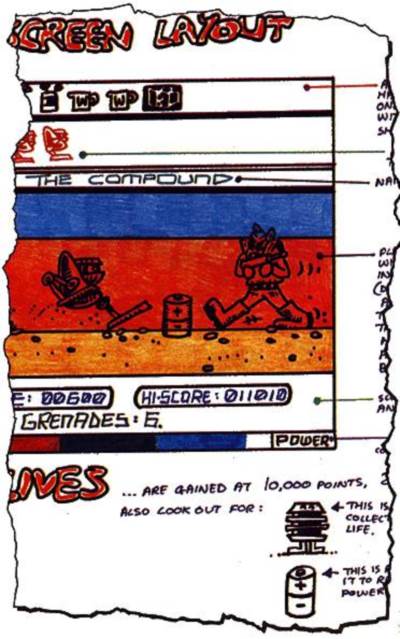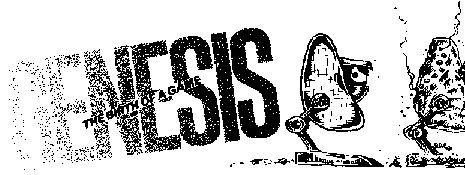

September was a busy month for Jonathan Eggelton, designer of the first GENESIS game. Not only was he working on the game graphics for Graham Stafford, but he also went to Domark’s HQ for a briefing on how the game would be taken to the marketplace. And a trip to Ludlow had to be fitted in to discuss the inlay artwork with Oliver Frey. Meanwhile, there’s a full preview of KAT-TRAP...
Domark’s founders and joint managing directors, Dominic Wheatley and Mark Strachan come from a marketing background — the duo met while they were working at a London advertising agency. They entered the home computer industry some three years ago, bringing a certain marketing flair with them — all their games have been launched and promoted in an original and strong way.
A great deal goes on behind the scenes before a finished program arrives in the High Street shops — and there’s much more to the process than just booking a few ads, duplicating the cassettes and waiting for orders to flood in. There’s the Public Relations side of things to deal with — spreading the word about a product without actually buying advertising space. Someone has to take care of liaison with the editorial staff working on computer magazines, newspapers, radio and, if the game’s very lucky, television. Like a lot of companies in the software industry, Domark pays for the services of a Public Relations (PR) firm to do all sorts of useful things that help the game get into the public eye.
Domark’s PR firm is called Inter-Mediates, and it was the cuddly Dave Carlos, Inter-Mediates bossman who collected Jonathan Eggelton and his mum Margaret from Milton Keynes and drove them to Wimbledon for the first marketing meeting. PR companies do “... all sorts of useful things...”!
Jonathan admitted that he’d never really thought about the way a computer program actually gets into the shops, so Mark Strachan set about explaining the process. Essentially, there are half a dozen elements to the process of marketing a game: setting the price; arranging for the artwork for promotional material; designing the packaging; setting up an advertising budget and strategy; arranging for distribution of the product and of course, the PR side of things.
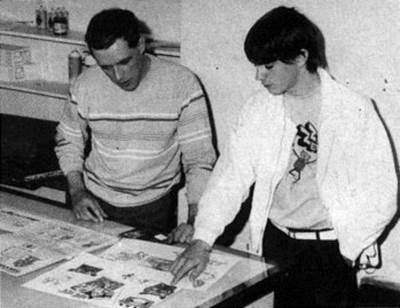
Oli and Jonathan chat about the artwork for KAT-TRAP. Next month, we’ll bring you the full story and show you Oli’s painting!
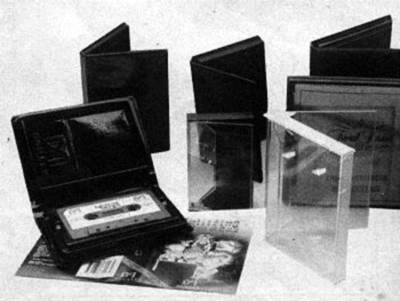
Just a selection of the packaging alternatives available. And of course, there’s always the possibility of designing and making a special box for a game. KAT-TRAP is likely to appear in a standard Domark library case, like SPLITTING IMAGES...
“All these element are interrelated,” Mark explained, “and the first thing Dominic and I do when we have a finished game on our hands is sit down together and go through the marketing plan. Then we have to think about the commercial side of things — at the end of the day, everyone’s got to make money out of a product. Perhaps the first consideration is the price, because the price that is charged in the shops affects the amount of money we have available to promote the game.”
When you actually buy a game in the shop, paying £7, £10, or maybe even £15, have you ever stopped to wonder why so much is charged for what is, after all, then than £1’s worth of materials? Lloyd’s postbag is usually brimming with letters complaining about the price of software — let Mark Strachan explain where the money goes:
“Say we decide to charge £7.95 for Kat-Trap. Over half the retail price goes to the shops, so that leaves about £3.00 for Domark. Out of that £3.00 we’ve got to pay for the box, the tape, labels, duplication and assembly costs — someone has to put the package together. Actually making the physical product which is sold in the shops could cost £1. That leaves us with £2.”
“Out of that £2 we have to pay for advertising and promotion, which could easily eat up half of the money remaining, and then there are the royalties that have to be paid to the programmer.”
Buying advertising space in computer magazines gets expensive very quickly. A full-page, colour advertisement in CRASH, for instance, costs about £1,000 and that’s not the highest price in the industry... In working out how much money to spend on advertising, the problem is, you don’t actually know how many copies of the game are going to sell. If a £7.95 price tag is decided upon for a game and at least 10,000 units sell, according to Mark’s breakdown of costs Domark could budget to spend about £10,000 on advertisements. That’s a lot of money — you could buy a very nice car or maybe a small house with such a sum... Why is it important?
“Advertising does many things,” Mark explains, “it informs people that your product is available, it gives the selling price and tells people where they can get the product. You need to tell people that they must have your product, but not tell them too much. In the software business, advertising makes the difference between a real success and an ‘also ran’.
“Apart from the consumer advertising, which is aimed at the end user, there’s the trade advertising to be taken care of too. The people involved in the distribution and retail side of the trade are very different — we can advertise to customers easily. We also need to tell the shops about a game — we have to tell a little story in a way explaining why people are going to come in and buy it. It helps to have quotes from magazines, and it’s useful to explain our consumer advertising and promotion plans as well. We’ll probably take advertisement space in COMPUTER TRADE WEEKLY which circulates to people in the home computer industry and produce some A4 ‘flyers’ — leaflets which tell the retailer about our game, explain why it is going to sell and aim to persuade him to stock copies.”
Once an advertising budget has been set, bookings have to be made with the publications — and everything has to be planned carefully, because publishers need to know in advance who wants to take advertising space in an issue of a magazine. Advertisements that appear in this issue of CRASH for instance, were booked before the middle of September and had to arrive in Ludlow, ready to go to the printers, before the end of September. You can’t always get an advert in at the last minute!
“In the case of a Spectrum/Amstrad game like Kat-Trap, we’d usually take space in CTW and ten or a dozen consumer magazines,” Mark says, “and we have to decide how we’re going to spend the money across the publications. We never advertise a product until it’s ready — it just confuses customers.” And wastes their time — Lloyd has quite a few letters from people who’ve seen a game advertised and spent time and money going to the shops looking for it...
The packaging is an important part of the ‘marketing mix’. Shelf space in High Street stores costs the retailer quite a lot of money, and shopkeepers want to make the best possible use of the display space they have available. Some large retail chains lay down the sizes for computer game boxes — and if you don’t comply with their standard sizes, your game simply doesn’t get onto their shelves. It all has to be borne in mind...
“We’ve got two alternatives when it comes to packaging,” Mark says, fetching some examples of previous Domark games, “we can use our standard cassette library case — the one used for Splitting Images, or we can produce a special box as we did for Eureka! and Trivial Pursuit. The problems with special packs are that they can’t be recycled, they’re more expensive and they have to be specially made, which takes longer. Our standard case fits in with the requirements of Boots, WH Smiths and so on, yet stands out a little bit, so we’ll probably use the library case for Kat-Trap.”
The artwork used on the inlay and for advertisements and posters has to be commissioned and prepared in time to meet up with printers’ schedules. Advertisements need to be similar, if not identical, to the packaging and the logo and artwork are crucially important to the whole process of marketing a game. As well as being written and published by some of the top people in the industry, Kat-Trap is getting off to a good start on the artwork front — Jonathan has been working on ideas for the central character for months, and is a keen artist. And Oli has agreed to paint the picture that will be used. More of that, a little later...
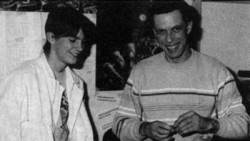
A quick tutorial on airbrush techniques from Oli. RULE ONE: open the window before spraying that niffy orange ink that smells as if someone’s thrown up!
Mark has nearly finished explaining the work Domark will be doing for Kat-Trap: “Once the product has been advertised and manufactured, the final stage is to arrange the distribution. We haven’t got the time or the facilities to deal with all the shops that sell software, and our customers are in fact about a dozen in number — they are the distributors and large chain stores.
“We have to ring up, make an appointment and go and tell them about a game, giving them details of the advertising budget and the reviews we’ve had, if any. It’s not an easy task — last year, for instance, Smiths were offered 1,500 games and actually took 75 of them!
“Orders have to be secured and then, the day before the launch, we have to ship games to distributors. Every customer of ours MUST get the game on the same day — everyone wants to get their hands on the product immediately. In fact; the same day isn’t good enough — we’ve found it has to be the same hour. A shopkeeper usually deals with more than one distributor and if he wants copies of a new game, he’ll approach one distributor — if that distributor hasn’t received the game and can’t supply immediately the shopkeeper will go to another distributor. To avoid the bad feeling this causes, we hired twelve vans to take Trivial Pursuit to our twelve customers and we told the drivers to wait outside the warehouses until noon before actually going in and making the delivery.
“Once they’ve got the product, distributors ring round the shops they supply selling the game in for us, and all we have to do is sit back and wait for the phone calls from distributors, asking for more supplies... If the game is a hit, we’ll get several calls a day from each distributor and that’s very nice!”
In many respects, the customer has got the easy job — okay, you’ve got to find the £7.95 from somewhere, but all you have to do is go into the shop and buy the game. It takes a long time for Domark or any other software publisher to see their share of your money, however. The shopkeeper puts your money into his bank account that evening and then has to pay the distributor — usually within 60 days. That’s three months. Then the distributor has to pay the publisher — which can take even longer. But of course the publisher has to pay printer’s bills, advertising bills and the costs of actually producing and shipping the cassette. When Jonathan went to see Domark, in the middle of September, over a million pounds was riding on Trivial Pursuit — publishing software certainly isn’t trivial!
After lunch at burger bar overlooking the home of the Wombles, it was back to the offices and time for Dave Carlos to explain his role in the marketing of a game. Dave used to be the editor of HOME COMPUTING WEEKLY and so thoroughly understands the way computer magazines work. This helps him a lot when it comes to liaising with the computer press... He’s been involved with the GENESIS project right from the start, liaising between CRASH, Design Design and Domark.
PR work starts months before the launch of a game. “We get involved with the marketing plan,” Dave explains, “and have to work out how to tell the media in general that a game is on its way. Television, newspapers, Micronet, magazines and of course European publications all have to be informed. Domark is one of the clients we provide a PR service for, and in their case we get involved right at the start. We can spend days, or even weeks thinking about the ways in which we can actually present a new game to the press. A launch party could be held at an interesting place that has a connection with the game, for instance — in the case of View To A Kill the game was launched at Pinewood studios and journalists were invited to a screening of the film that took place a week before the Royal Premiere.
“It is the PR company’s job to provide backup to the publisher and deal with journalists. We have to arrange for photographs to be taken and supplied to magazines, and have to come up with interesting ideas that will get people talking about the product — the aim is to reinforce the message that the product is NEW!
“When a game is getting close to launch, it’s time to start thinking about promoting it through competitions — the PR side is very different to advertising. We spend time thinking about crazy ideas and then seeing if we can actually do them — for TP, a solid gold Trivial Pursuit set is being made and will be given away as the prize in a national competition. For the next Bond game, we investigated the possibility of setting up a photo session with Mark and Dominic and some alligators, but the whole idea turned out to be too expensive.” (Relief washes across Mark’s face at this point!)
Dave Carlos is given a budget to work with, and has to allocate cash for competition prizes and cover other launch expenses such as the hire of a venue and the food and drinks bill for Hunter S Minson and his friends! A good rapport with magazines and customers is important to a software publisher, and Dave works for a number of clients as an intermediary, in effect. He takes care of all the administrative work involved in sending out press releases, arranging photographs, holding a launch party and inviting the right people, sorting out promotional products like badges, T-shirts and hats, and ultimately, presenting the game to magazines.
“With Kat-Trap Mark and I will try to see all the magazine editors personally taking the game with us and demonstrating it. It’s just possible to cover all fifteen magazines in London, visiting each of them, in a single day but it’s not the best way to do things — it’s very tiring and hard work!
“And the final part of the PR company’s job is to be on the end of a telephone sorting out queries and problems. If a journalist wants to know the price of a game, the name of the author or the age of the designer; it’s up to me to pass on the information quickly and efficiently.”
Well, Kat-Trap is the GENESIS game after all... Last month we reported on the way Graham Stafford planned to implement Jonathan’s design. Then, only the bare skeleton of the game had been assembled but Graham and Jon have been beavering away and Kat-Trap is moving, and ready for a preview. With the delays involved in producing CRASH, by the time you read this, the game should be finished!
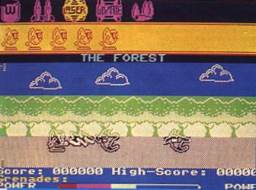
M.T.-ED. tackles some Shadow Ghosts. They’re pretty elusive, however, as they flit in and out amongst the trees.
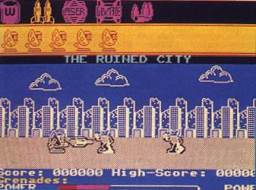
The Kat Warriors confront our hero in the ruined city
It is the 24th century and Earth has been abandoned by the human race for two centuries — solar explosions forced a huge evacuation. Now, the Earth people deem it safe to return to their home planet. However, when they arrive they face a shock for although the planet itself seems to have survived quite well, squatters have moved in. Mother Earth has been taken over by the Cat Men!
The World leaders want their planet back, but there’s no point pottering off to the County Court for an eviction order — the Cat Men aren’t going to give up without a fight. From enforced exile the Earth men hatch a plan. They send down a sophisticated Multi Terrain Exploration Droid, affectionately known at M.T.-ED. He’s not really a combat droid — M.T.-ED. was designed to potter over awkward terrain and maybe get involved in a bit of scrub clearance, but fighting... well, it’s not really his forte. A few weapons are bolted on to M.T.-ED. and he’s sent down to Earth along with Hercules-1, a maintenance and command droid. A reluctant hero, M.T.-ED. sets out to oust those unwelcome Cat Men for good.
At the moment two screens are nearly complete — the ruined city and the forest area. In Jonathan’s original game plan there are fourteen levels, ranging from lakes, deserts, mountain peaks, and castles. And Graham Stafford reckons all these levels will be included in the finished game...
Apart from the ravenous Cat Men who are possessively guarding “their” planet, other nasties have to be dealt with. Ghost-like shadow men drift in and out of the forest areas and Mechno Cats roam around chewing up anything daft enough to get in their way. A sinister sewer beast grabs at victims from manholes and all manner of undesirables have joined forces with the Cat Men. Points are scored for all the baddies blasted to their doom.
M.T.-ED. moves around by scurrying along or by taking a series of bouncy hops — even in the game’s present embryonic state he sproings around in a very convincing mechanical way. To defend himself against the dangers, M.T.-ED. has a variety of weapons at his disposal. However, not all these are effective against all of the invaders. Water cannon, missiles, a powerful laser, grenades and bullets should all be available in the finished game — the heroic droid must stomp through each successive level eradicating the dangers that meet him and selecting the correct weapon for each type of baddie he meets.
Although the work on the game has progressed a great deal from the last time it was viewed, there is still quite a bit more to do. Changes will probably be made to the scenario and structure right up until the last minute. But you’ll have to wait until next issue, when we’ll have a full review before you’ll know the whole story.
The original screen design from Jonathan’s GENESIS entry. Mr Stafford’s keen to keep as close as he can to the original brief, as you can see from the screenshots...
